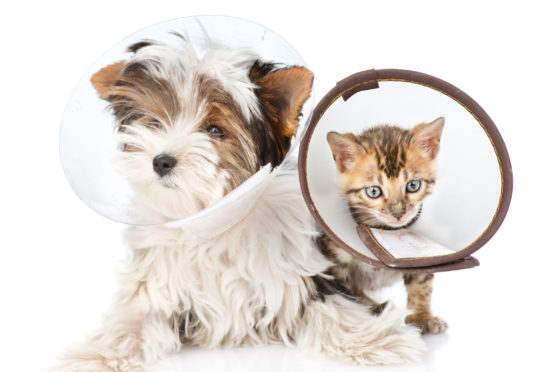
They are the plastic cones worn by pets who have undergone surgery to prevent reinfection.
But researchers fear they can damage the mental and physical health of more than three-quarters of pets.
Owners reported that stressed cats and dogs can go off their food, develop odd behaviours and, in a quarter of cases, badly injure or even choke themselves.
Now veterinary experts, who have carried out the first ever research into the cone’s side effects, have recommended that they are used as a last resort.
The cones are known as Elizabethan collars after the high ruffed collars fashionable during the 16th Century.
The international report, co-authored by animal welfare expert, Glasgow University’s Dr Dorothy McKeegan, stated: “We found that the majority of participants (77%) reported a poorer quality of life in their companion animals while the collar was worn.
“Elizabethan collars might have negative welfare impacts including nutrition, environment, health, behaviour and mental state.
“We recommend that animal owners are informed about potential negative impacts of Elizabethan collars and harm minimisation strategies. Where possible, alternative methods of preventing self-trauma should be explored.”
Named after the elaborate linen neck ruffs worn by Elizabeth I, the first cones were a Victorian invention and made of wood, leather or steel.
Now mostly made of plastic, and either tied, or Velcroed together, they protect a pet’s wound after surgery or treatment, while it heals. But they can cause their own problems, too. Almost 500 owners – whose pets had worn a cone in the past 12 months – were surveyed. Over three-quarters reported a poorer quality of life in their pets while the collar was worn.
More than 25% said their animal had experienced an “Elizabethan collar-related injury, including trauma due to bumping into walls or objects or falling downstairs, and psychological distress”.
They also developed infections because they could not wash properly, lost weight because they could not feed themselves, or even developed an allergy to the plastic.
Some owners perceived that their animal’s stress associated with wearing the Elizabethan collar was “a bigger welfare issue than the problem the collar was intended to address”.
Owners reported that animals wearing Elizabethan collars were “prone to misadventure, frequently describing a tendency to walk, run or otherwise bump into objects or people, or an increased frequency of falling”.
A number of owners reported that their animal had pre-existing anxiety, which was exacerbated by the collar.
In extreme cases “ill-fitted collars and inadequate monitoring can result in injuries for pets, possible deaths”.
The report in the journal Animals concluded: “Despite the ongoing use of Elizabethan collars in veterinary medicine, we have shown that they may negatively impact animal welfare.
“Numerous alternatives to Elizabethan collars are available and the efficacy of these should be explored.
“Physical alternatives to Elizabethan collars include inflatable collars, neck restraints, visors, muzzles, socks or booties.”
Ian Futter, chief veterinary officer with the Scottish SPCA, said: “I have seen a death. If a dog tries to go through a narrow opening, wearing a collar and caught the edge of the collar on the doorway it could cause injury to the dog’s neck. So they should really only be given out with appropriate advice and caution to use if the dog seems to be tolerating it.
“Vet surgeons should make a risk assessment deciding on an individual basis whether it is appropriate to apply one or not.”
Pet trainer Victoria Stilwell, from BBC1’s One Show Help! My Dog is Out of Control, said: “This is all part of training.
“I train all puppies to wear Elizabethan collars – or a softer version, teaching them right from the beginning that wearing a collar is okay.”

Enjoy the convenience of having The Sunday Post delivered as a digital ePaper straight to your smartphone, tablet or computer.
Subscribe for only £5.49 a month and enjoy all the benefits of the printed paper as a digital replica.
Subscribe